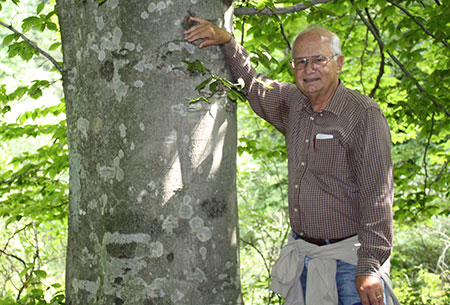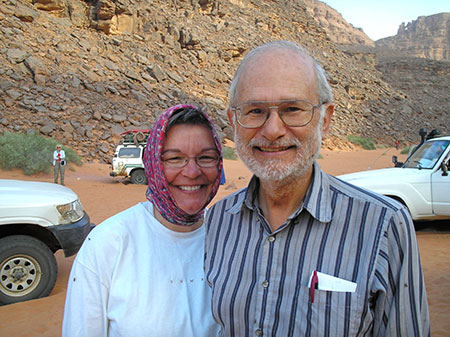Navajo and Other Southwest Interests
 A 1946 transcontinental family trip, The National Geographic Magazine, Arizona Highways, and a 1955 family jaunt to western Colorado sparked a teenage interest in the Colorado Plateau. In 1959, I engaged in Geology undergraduate-thesis fieldwork in New Mexico’s Chuska Mountains, with Herbert E. Wright. Although my initial interest was geomorphology—physical-landscape genesis—I became increasingly fascinated by the human geography and archaeological remains of the region, especially of the Anasazi and the Navajo. My doctoral dissertation was on scenic resources and tourism development in the Navajo Country, fieldwork for which took me all over that region and also involved some months at the University of Arizona in Tucson, where I took a course in Southwest archaeology and completed a paper on Ancestral Puebloan abandonments, published in American Antiquity in 1964. The Navajo Tribal Museum published my dissertation in 1966, and a few tourism-related articles have come out in subsequent years.
A 1946 transcontinental family trip, The National Geographic Magazine, Arizona Highways, and a 1955 family jaunt to western Colorado sparked a teenage interest in the Colorado Plateau. In 1959, I engaged in Geology undergraduate-thesis fieldwork in New Mexico’s Chuska Mountains, with Herbert E. Wright. Although my initial interest was geomorphology—physical-landscape genesis—I became increasingly fascinated by the human geography and archaeological remains of the region, especially of the Anasazi and the Navajo. My doctoral dissertation was on scenic resources and tourism development in the Navajo Country, fieldwork for which took me all over that region and also involved some months at the University of Arizona in Tucson, where I took a course in Southwest archaeology and completed a paper on Ancestral Puebloan abandonments, published in American Antiquity in 1964. The Navajo Tribal Museum published my dissertation in 1966, and a few tourism-related articles have come out in subsequent years.

Always an environmentalist and scenic-preservationist, in 1966 I offered my expertise to the Sierra Club in its struggle to prevent two dams from being constructed in Grand Canyon, working with Navajo Tribal Attorney Norman M. Littell and twice testifying in behalf of the Navajo Tribe before a House subcommittee in Washington. The dams were defeated, the National Park enlarged, and Navajo Tribal Parks created. The Sierra Club’s David Brower asked me to write the text for the Club’s Exhibit Format Book Navajo Wildlands: ‘as long as the rivers shall run’, which, in its hardcover (1967) and softcover (1969) editions sold 82,000 copies and won graphic-arts awards. During 1968 and 1969, I was Sierra Club representative to the legislation-drafting sessions that led to California’s Porter-Cologne Water Quality Control Act.
In 1969, Sierra Club board member and Sunset Magazine travel editor Martin Litton organized a three-week descent of the Colorado River in Grand Canyon for people associated with the Club’s anti-dam efforts, and I was an enthusiastic participant. Litton’s dory trips turned up ancient split-twig figurines in Stantons Cave, and over the years I published on these and other such finds. On the trip were two photographers who had done work for the Sierra Club, Dave Bohn and Clyde Childress. We later made two backpacking expeditions down Kanab Canyon, Grand Canyon’s major north side tributary, and I published on Kanab’s biogeography.

Following visits to Rainbow Natural Bridge in connection with two personal raft descents of the Colorado River’s Glen Canyon (1959, 1962) plus a jaunt on a rising Lake Powell following a 1963 Escalante Canyon hike, my interest in the Bridge grew, and I published three pieces on Native perceptions and the human history of the span, which also had implications for the feature’s conservation.
At UC Davis, my student Virginia Evelyn Spencer undertook, at my suggestion, an M.A. thesis on Navajo settlement and architecture in Black Creek Valley, AZ, on which we published an article. She later collaborated with me on the book Navajo Architecture: Forms, History, Distributions (1981). Subsequently, she pursued a career in Indian housing. I also produced additional articles on Navajo settlement patterns and dwelling types as well as on Navajo cemeteries. I contributed invited articles on Southwest dwelling types to Cambridge University Press’s Encyclopedia of Vernacular Architecture of the World (1997). Cairn trail shrines in the Americas also became an interest, starting with Navajo ones.
With Bohn and Childress, around 1971 I began working in Canyon de Chelly, AZ, with the Navajo elder Chauncey Neboyia and others, publishing a number of articles, including on fruit-tree-raising and pictographic star ceilings. My book Navajo Placenames and Trails of the Canyon de Chelly System, Arizona appeared in 2001. I have also published articles and chapters on Navajo placenames and on material-culture topics. Too, Bohn and I issued House of Three Turkeys: Anasazi Redoubt (1977), concerning a gemlike cliff dwelling.

Over the years, I have researched and published on Navajo sacred places. I became acquainted with several medicinemen, at Navajo Mountain and Canyon de Chelly, and, especially, with Billy Yellow of Monument Valley. I hired Billy and his sons-in-law to build a hogan (dwelling) on land I own in Castle Valley near Moab, UT. I published a brief biography of another medicineman, Pete Price, whose grandson I knew.

The UCD fisheries biologist Peter Moyle and I published an article on the Gulf of California origins of the fishes depicted on prehistoric Mimbres pictorial bowls from southwestern New Mexico. Our work is prominently featured in the University of New Mexico’s Maxwell Museum of Anthropology.
I am a charter member of the Natural Arch and Bridge Society (NABS). In the earlier 1960s, I “discovered” a large but remote natural arch to the east of what is now Lake Powell, and officially named it for my father. In 2006, Lisa and I went on a NABS expedition to the Algerian Sahara, trecking with the Tuareg (http://www.naturalarches.org/tassili/journal.htm; see photo), and in 2010 I participated in a NABS journey to South China to document the world’s largest natural bridges and arches (http://www.naturalarches.org/china/journal.html#fairybridge; see photo).
Current Southwest research projects include the history of Navajo farming (stemming from a 1985 School of American Research Advanced Seminar paper), Navajo sweathouses, and a major guidebook to the Four Corners Indian Country.